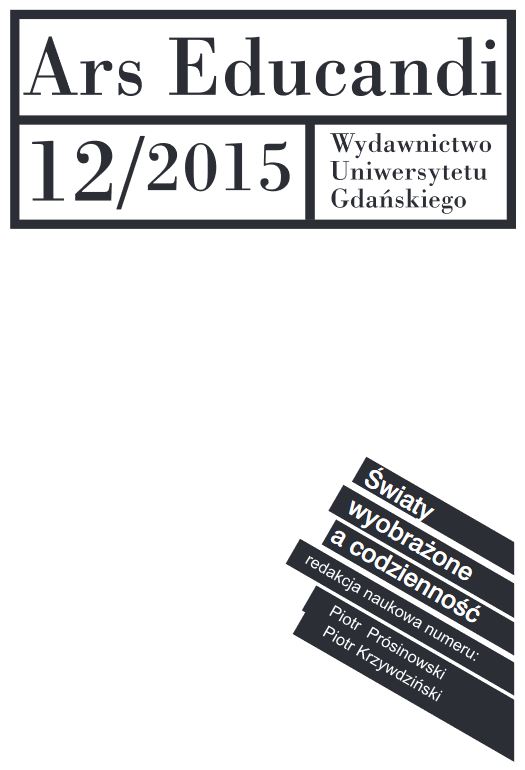Oniryczne inkarnacje: konstrukcje snów w wybranych grach wideo
DOI:
https://doi.org/10.26881/ae.2015.12.07Słowa kluczowe:
gry wideo, game studies, analiza tekstu kultury, wirtualna rzeczywistość, snyAbstrakt
Ludzkość zawsze przywiązywała dużą wagę do snów oraz onirycznych wizji. W miarę rozwoju cywilizacji wizerunek snów przenosił się na coraz to nowsze media: obrazy plastyczne, literaturę, filmy. Sny pojawiają się jako znaczące także w branży gier wideo. Nierzadko są kluczowe dla fabuły. Deweloperzy, osoby odpowiedzialne za projekt gry, twórcy tekstów/dialogów przenoszą swoje rozumienie, popularne wizje snów do swoich produkcji; adaptują ich codzienne oraz mityczne cechy, eksponując sny w skonkretyzowany sposób, naprowadzający na konkretne interpretacje tegoż zjawiska. Celem artykułu jest dekonstrukcja tychże ekspozycji, wirtualnych konstrukcji snów i nocnych wizji w wybranych grach wideo oraz ukazanie znaczeń nadawanych snom przez twórców gier.

Modernizacja działania Czasopisma oraz tłumaczenia na język angielski artykułów Ars Educandi na lata 2012-2017 zostały sfinansowane ze środków Ministerstwa Nauki i Szkolnictwa Wyższego z zadania Działalności Upowszechniającej Naukę (DUN).
Zadanie: Wdrożenie modułu redakcyjnego na platformie Uniwersyteckich Czasopism Naukowych - systemu wspomagającego redagowanie i zarządzanie czasopismem naukowym Ars Educandi sfinansowano w ramach umowy 661/P-DUN/2018 z dnia 12.06.2018 ze środków Ministra Nauki i Szkolnictwa Wyższego przeznaczonych na działalność upowszechniającą naukę.
Zadanie: Stworzenie nowoczesnej wersji on-line czasopisma Ars Educandi przez wdrożenie modułu publikacyjnego na platformie Uniwersyteckich Czasopism Naukowych oraz obsługę międzynarodowych baz indeksacyjnych sfinansowano w ramach umowy 661/P-DUN/2018 z dnia 12.06.2018 ze środków Ministra Nauki i Szkolnictwa Wyższego przeznaczonych na działalność upowszechniającą naukę.
Zadanie: Przygotowanie anglojęzycznej wersji ostatnich 6 roczników (2012-2017) czasopisma naukowego Ars Educandi i ich wydanie w wersji online sfinansowano w ramach umowy 661/P-DUN/2018 z dnia 12.06.2018 ze środków Ministra Nauki i Szkolnictwa Wyższego przeznaczonych na działalność upowszechniającą naukę.
Downloads
Bibliografia
Beksiński Z., 1978, Sfotografować sen [rozmowa przeprowadzona przez J. Czopika], „Tygodnik Kulturalny” nr 35.
Bogost I., 2007, Persuasive Games. The expressive power of videogames, Cambridge: MIT Press.
Busse-Brandyk A., Chmielewska-Łuczak D., 2009, Narracyjne gry fabularne jako droga do nieświadomości, „Homo Ludens” nr 1, http://ptbg.org.pl/HomoLudens/bib/8/ [dostęp: 24.02.2016].
Caillois R., 1973, Żywioł i ład, wyb. A. Osęka, tłum. A. Tatarkiewicz, Warszawa: Państwowy Instytut Wydawniczy.
Cielecka M., 2014, Brzemię interaktywności – erotyka i seksualność w grach komputerowych, „Replay. The Polish Journal of Game Studies” nr 1.
Cunningham E., 2004a, Córka mrocznego Elfa, tłum. P. Kucharski, Warszawa: Isa
Cunningham E., 2004b, Splątane sieci, tłum. P. Lewandowska, Warszawa: Isa.
Eliade M., 2013, Kowale i alchemicy, Warszawa: Aletheia.
Freud S., 1996, Objaśnianie marzeń sennych, tłum. R. Reszke, Warszawa: Wydawnictwo KR.
Hall C.S., Lindzey G., Campbell J.B., 2010, Teorie osobowości, tłum. J. Kowalczewska, J. Radzicki, M. Zagrodzki, Warszawa: PWN.
Kępiński A., 2012, Lęk, Kraków: Wydawnictwo Literackie.
Kruszelnicki M., 2010, Oblicza strachu. Tradycja i współczesność horroru literackiego, Toruń: Wydawnictwo Adam Marszałek.
Nilsson U., 2012, Rozmowa na tematy tabu może pomóc dzieciom [w:] Tabu w literaturze i sztuce dla dzieci, red. B. Sochańska, J. Czechowska, Warszawa: Duński Instytut Kultury, Poznań: Media Rodzina.
Nyhus S., 2012, Niewidzialne dzieci, depresyjne matki i krzyczący ojcowie [w:] Tabu w literaturze i sztuce dla dzieci, red. B. Sochańska, J. Czechowska, Warszawa: Duński Instytut Kultury, Poznań: Media Rodzina.
Prósinowski P., 2015, To, co męskie, to, co kobiece. Konstrukty płci i seksualności w grach komputerowych [w:] Codzienność, performatywność, demokracja: pedagogika wobec norm życiowych i problematyki nienormatywności, red. L. Kopciewicz, B. Simlat-Żuk, Gdańsk: Wydawnictwo Naukowe Katedra.
Prósinowski P., Ranachowska J., 2014, Męskość na waszych ekranach: konstrukty mężczyzn i ich seksualności w komputerowych grach fabularnych, filmach i reklamach, „Ars Educandi” t. 11.
Szeja J.Z., 2004, Gry fabularne – nowe zjawisko kultury współczesnej, Kraków: Rabid.
Topp I., Fereński P.J., Nahirny R. (red.), 2014, Sny w kulturze. Szkice dedykowane Profesorowi Stefanowi Bednarkowi, Warszawa–Wrocław: Wydawnictwo Korporacja Polonia.
Gry wideo:
BioWare, 1998, Baldur’s Gate II, CD Projekt.
BioWare, 2000, Baldur’s Gate, CD Projekt.
BioWare, 2009, Dragon Age: Początek, Electronic Arts Polska.
BioWare, 2011, Dragon Age II, Electronic Arts Polska.
BioWare, 2014, Dragon Age: Inkwizycja, Electronic Arts Polska.
Ice-Pick Lodge, 2008, Tension, Techland.
Krillbite Studio, 2014, Among The Sleep, Krillbite Studio.
Obsidian Entertainment, 2007, Neverwinter Nights 2: Maska Zdrajcy, CD Projekt.

 Uniwersyteckie Czasopisma Naukowe
Uniwersyteckie Czasopisma Naukowe




